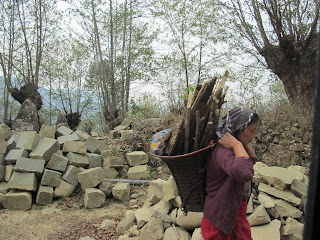Leaving Dimapur at 4PM, we reached the village of Khonoma after dark at almost 7PM, and stayed at Valley View Homestay, where we shared the bathroom with the driver. The bathroom had no shower or sink or drain, but it did have a toilet and containers of water to flush with. We were brought some pails of hot water, but were not sure how to bath properly without a drain for the room, and so were quite grungy after two nights!
We ate dinner of rice and chicken curry with our host family, a carpenter, his wife, two daughters and son plus three cats and three kittens who played by the fire.
Thursday - Rising with the sun a t 5:30AM, we ate breakfast at 7AM and were off to see the village of Khonoma, which is a stronghold of the largest of the 16 Naga tribes, the Angami. All of these tribes were headhunters and independent, but the village of Khonoma was known for actively fighting against sieges by the British in 1847 and 1849. It was cool and sunny at an altitude of about 4,000 feet, and has extensive terraced rice fields in the valleys below the village. We saw different fortifications, places for ceremonies, trials by village elders, and for the children to learn Angami culture.
 |
| Alder Tree farming for fire wood |
Most of Nagaland was converted in the 1800’s from animism to Christianity, and there are several churches in the town, the largest of which is Baptist, although there is an impressive Catholic one as well as several others. Leslie was interested in women doing weaving with back strap looms. We then drove up the valley to a school where an NGO was holding a week-long seminar to train about 20 people in how to encourage preserving bird life and butterflies, and doing so in a way to encourage ecotourism. We had a chance to talk to the group about our interests and view the new bird book for Nagaland, which is included in this part of the eastern foothills of the Himalayas as one of two biodiversity hot spots in India, the other being the Kodai area of the Western Ghats, where we had just come from.
In the afternoon we went birdwatching, and saw some interesting pheasants and a green Bulbul with a black head, but without a book, we have not identified much. The Nagas have ownership of the wild Bison in their territories, and provide them with salt to keep them semi-tame, and we saw a herd of them that were treated almost like cattle.
We had dinner at the home stay around 7pm and got a bucket of boiling water to mix with the cold buckets already in the "bathroom" to try and clean up abit. We read our books and huddled in our cocoon silk sleeping sacks with blankets and listened to the wind howl through the valley. Over the windows and doors they have drilled holes so that there is ventilation.


No comments:
Post a Comment